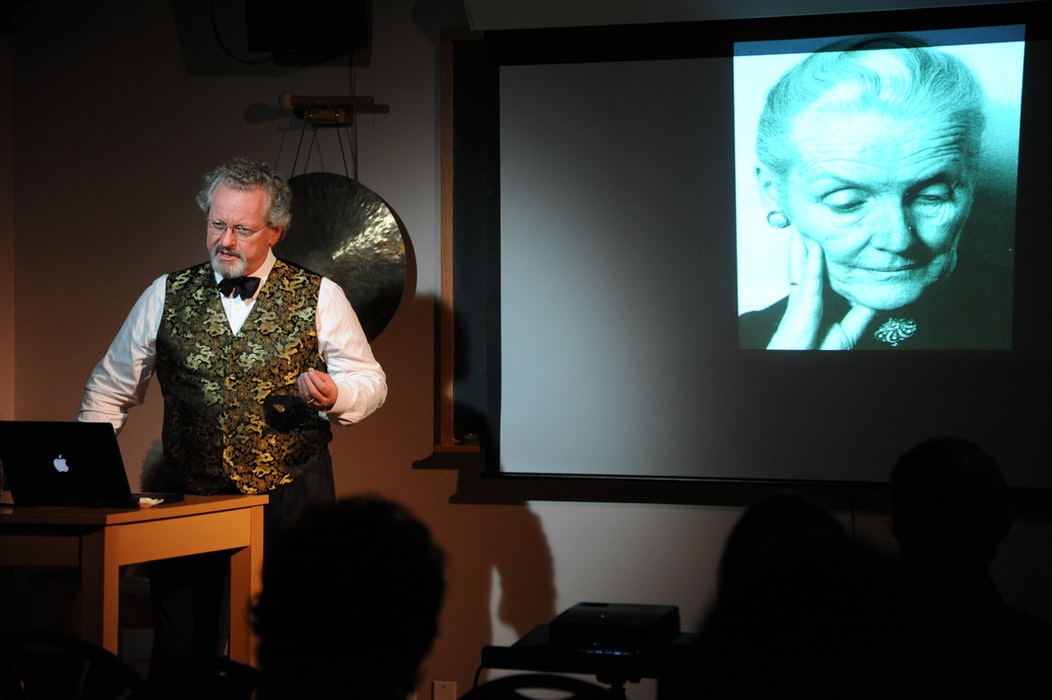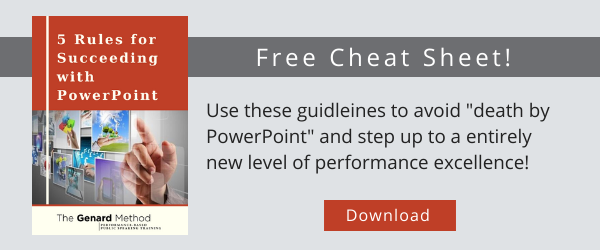Do you know how to use a slide deck to engage listeners? Here are 4 ways to master PowerPoint to inspire audiences.
I'm sure the inventors of PowerPoint meant well. Microsoft, too, which acquired the product shortly after it hit the market.
Unfortunately, we've been hit with it ever since.
Want a handy guide for actually performing well while using PowerPoint? Download my Free cheat sheet, "5 Rules for Succeeding With PowerPoint."
To be fair, it isn't only the fault of the designers and company that acquired the product. PowerPoint is a perfectly serviceable presentation tool—when it's used appropriately. But too many presenters don't do that. I won't argue against this now-inescapable presentation tool from a visual designer's standpoint, as Edward Tufte does. I take a performative stance on PowerPoint. And that's where some real problems occur.
Here's a quick tour of reminders and remedies where the effective performance of PowerPoint is concerned.
Do you know how to create lasting influence with business audiences? Discover how in my Free eGuide, "4 Characteristics of An Influential Speaker."
PowerPoint is Visual Not Literary
How did this go wrong, so rapidly? I can see future cultural critics saying, as they did of Orson Welles (look him up): "P. Point, you had such potential! Why didn't you ever realize it?"
Realize your own potential! Connect with audiences, don't just deliver information. Learn how in my Free resource, "Great Speaking? It's About Performance Over Content."
This presentation tool is actually great at doing what it's designed to do: show some things in visual terms that can't be adequately explained otherwise. Think of a real estate agent showing photos of a home on the market, or a dentist or surgeon showing colleagues the steps in a medical procedure. Or, yes, a chart or graph which demonstrates data dramatically.
But, let's face it: that doesn't mean bullet points with some words after them. Here's the key to using this tool productively: display a strong visual image, then talk about it. Obviously, you chose that image for a reason. Let it grab viewers. Then explain it, place it in context, tell why it matters concerning your topic and your listeners, etc. Render unto PowerPoint what is PowerPoint's . . . and unto yourself what is yours to give!
Learn more on commanding the room (or cyberspace) when you speak! Get my Free eBook, 12 Easy Ways to Achieve Presence and Charisma.
PowerPoint Wants to Lead You Through the Nose
Everybody on Planet Earth uses PowerPoint . . . and I'm afraid it's gone to P.P.'s head. Okay, it's just a visual software tool and it doesn't think. But if it did, can't you just hear it saying, "I'm powerful, dude. I suck everybody in, and they all pay attention when I show up! You, presenter, are just here to click the forward arrow and stay out of the way. If you're good, I'll let you read my bullet points out loud."
In other words, P.P. loves placing a ring in your nose and pulling you along. Don't let it! Remember that you are the influencer in the room, not this software which doesn't have a mind of its own. (Sorry, P. P.!) It is there to serve your story, not the other way around. And so . . .
Tell Your Story, and Weave PowerPoint Into It
This is at the heart of effective performance using PowerPoint: your story should rule, not the tool you're using to tell it effectively. Really, would a drawing pencil and a sketch book make you a good artist?
Do you show leadership qualities when you speak? Raise the bar on your performance! Get my Free eBook, High-Impact Speaking: The Leader's Guide to Presenting with Influence.
Powerful storytelling matters as much when you're using a slide deck as when you're not. The same rules apply concerning understanding your listeners, crafting a talk solely for them, living in their world and using references they will relate to as you discuss your topic. And most important, connecting with them emotionally so they see that what you're saying is really all about meeting THEIR needs.
Stay focused that way. Tell the story they need to hear, and bring in each slide when it has the most impact. (And as I say above, that means visual impact.) Speaking of the impact of your slides, see my concluding point, below.
Use Your Real Estate Assets Wisely
Stop wasting the valuable real estate that is your slide-space. I'm talking here specifically about headings and title slides. If you think in terms of an effective performance, you'll realize that you're missing out on recurring opportunities to keep your story moving forward. Sort of like missing a heartbeat, regularly.
Think of what the headings of slides typically say: "Outline," "Agenda," and my favorite, "Questions?" This is slide-sludge. Besides, they are seen so often (and without purpose) that they are basically invisible. Instead, slide headings are valuable opportunities to move your persuasion or advocacy forward.
Consider the difference between, "Outline," and "What Are the Key Obstacles We're Facing?" or "How Do We Improve Customer Satisfaction?" What you talk about on that and subsequent slides will remain the same. But you've just taken a big step toward achieving your purpose in this talk.
Title slides accomplish the same task, with another benefit. They clearly alert viewers that a new section is about to begin. This is crucial in allowing your audience to digest what they just saw, and hit the refresh button in their brain for the new information coming. We're all much more receptive when we're being exposed to something new, rather than what seems to be more information on the same topic.
You should follow me on Twitter here.
Gary Genard is an actor, author, and expert in public speaking training and overcoming speaking fear. His company, Boston-based The Genard Method offers live 1:1 Zoom executive coaching and corporate group training worldwide. In 2021 for the eighth consecutive year, Gary has been ranked by Global Gurus as One of the World’s Top 30 Communication Professionals. He is the author of the Amazon Best-Seller How to Give a Speech. His second book, Fearless Speaking, was named in 2019 as "One of the 100 Best Confidence Books of All Time." His latest book is The Online Meetings Handbook, now available at The Genard Method and at Amazon. To know more about TGM's services, Contact Gary here.







